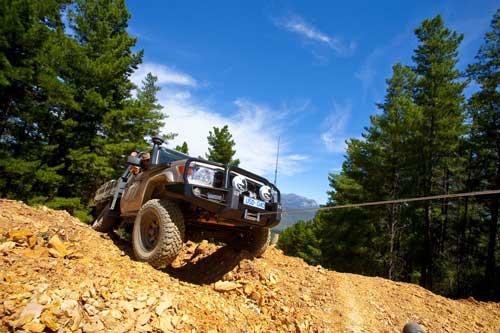A 4WD with mud tyres, diff. lockers front and rear, and a 2 inch lift, is an awesome vehicle. And in the hands of an expert driver it can go almost anywhere you’re likely to want to go.
However, if you rely only on your vehicle and your skill to ensure you complete every journey, well, to be quite frank, you’re being foolhardy, to say the least.
So what should you take with you in terms of recovery equipment?
Well, this is another one of those “how long is a piece of string?” questions. It all depends on where you’re going, and what you’re planning to do.
So what’s the minimum you should take with you?
There is a wide range of product available on the New Zealand market, and we always advise purchasing your recovery equipment from reputable suppliers, some of whom are mentioned on the following pages.
The minimum:
- Recovery bag – contains all the equipment in a water proof carry bag.
- Spade – ideal for digging you out of those tricky spots.
- Leather gloves – important you wear them while conducting a recovery exercise.
- Bow shaped shackles – used to connect the recovery rope to the vehicle’s recovery point – remember never tighten the shackle pin too tight.
- Kinetic strap – or snatch strap. Used to pull a stationary vehicle out of thick sand or mud (see Ashley Lucas’s TorqueTalk on p72 for more advice on this).
- Static pull strap – is used to tow a vehicle which may have broken down or is lightly stuck.
- Tree protector – this strap is used to protect a tree when it is used as an anchor point.
In addition we would take a first aid kit, a fire extinguisher, a torch, water and food, a space blanket, and a plastic sheet (in case you have to lie on the ground to attach tow straps). Plus at least a cell phone, GPS and/or a compass..
A high lift jack is another useful tool, both for jacking the vehicle out of a hole, or for use as a manual winch. Kits to turn your high lift jack into a winch are available, with 4WDBits offering a nice one. Oh, and you’ll need a stout piece of flat wood to put your high lift jack on so it doesn’t sink into the ground.
We have in fact used one of these as a winch, and it’s dead easy, though simplicity comes with a price – you have to use muscle power!
Another useful tool is a machete to cut back branches which might otherwise scratch your vehicle’s paintwork.
If we’re going to muddy or sandy ground we add in the Maxtrax traction tracks, and if we expect rough stuff we take an exhaust-driven jack (or even two), and ultimately a hand winch plus a ground anchor, usually the Lan-Cor because it’s lighter and more compact than our Firma-grip.
Of course, there’s no point in having all this equipment if your vehicle doesn’t have strong recovery points (not just the delivery tie-down points most vehicles come with). Have a look at the story “Recovery points” elsewhere on these pages for more details.
Always consult with your 4WD accessory specialist to ensure you purchase the correct equipment suitable to the type and weight of the vehicle you are driving.
Learn how to use all the various types of equipment mentioned above. You can go to a specialised trainer, join a club, or just go out with a bunch of experienced 4Wheelers. But don’t let the first time you need the equipment be the first time you get it out of the bag!
Finally, remember these two important points:
* You should never do anything you don’t feel comfortable doing, be it recovery or driving.
* There should be only one decision maker in any recovery, and that should be decided before you start. By all means consultation and discussion is good, but when it comes down to doing it one pre- decided person makes the calls.




